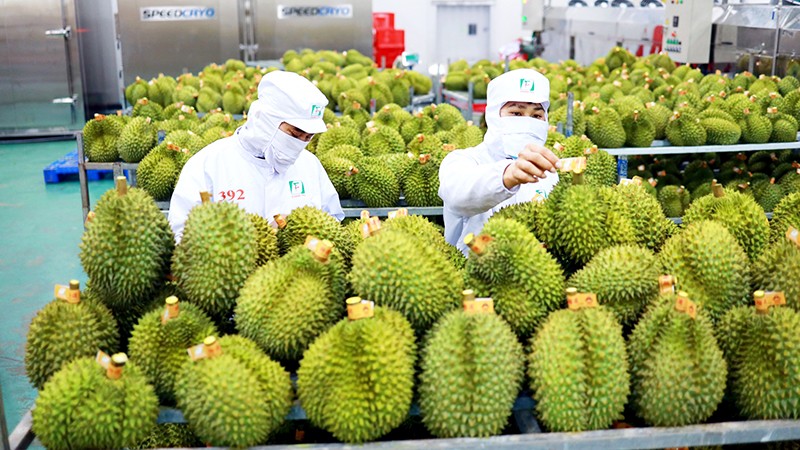Agricultures, Foods, News & Event
Export of vegetables and fruits: Potential from the market of billions of people
NDO – Since opening at the beginning of this year, China is still considered a potential market of billions of people for Vietnamese fruit and vegetables.

The potential for fruit and vegetable export to China is still great
Influenced by China’s Zero Covid policy, G.C Food Joint Stock Company has suspended exports to the billion-people market since 2019. As soon as China reopens, the business has planned to bring Aloe vera products return to this potential market.
Mr. Nguyen Diep Phap, Deputy General Director of G.C Food Joint Stock Company, said that the company always considers China as one of its very potential markets. This year, G.C will re-promote and especially may attend a fair in June to re-develop the customer base. “It is expected that the Chinese market will bring in more than 10% of revenue this year,” Mr. Nguyen Diep Phap expects.
Vegetables and fruits are one of the few items that can maintain export growth after the first months of the year. According to data from the Ministry of Agriculture and Rural Development, in the first two months of 2023, the export of vegetables and fruits reached US$592 million, an increase of nearly 18% over the same period in 2022. In which, China is the market. Vietnam’s main agricultural exports, accounting for 57.5%. The fact that China opens more Vietnamese fruit and vegetable products such as durian will help the export market of vegetables and fruits to be significantly improved.
In the context of global inflation and declining orders, vegetables and fruits are one of the few main agricultural products with growth at the beginning of the year, when most other key export items have declined. In which, China continues to be Vietnam’s largest fruit and vegetable consumption market in the first months of this year, accounting for 57%, followed by the US, Japan and South Korea.
According to statistics of the Ministry of Industry and Trade, in recent years, China has been the largest export market for Vietnam’s fruit. In which, lychee accounts for 90% of the export volume to foreign countries, dragon fruit accounts for more than 80%. Especially, with cassava and cassava products, China is the largest market (91.47%); rubber accounted for 71.91%.
Sharing about the potential of fruit and vegetable products in China, Mr. Nguyen Thanh Binh, Chairman of the Vietnam Fruit and Vegetable Association shared, starting from January 8, China has opened its entire border, creating convenient for trade, commerce and travel between the two sides. It is an opportunity for Vietnam’s fruit and vegetable exports to continue to recover and grow.
“Currently, according to the Vietnam Fruit and Vegetable Association, China has sent many delegations to Vietnam and even has requests for very large orders, such as durian orders. This is a great potential for fruit and vegetable exports in the future,” said Mr. Nguyen Thanh Binh.
Fruit and vegetable exports to China may reach 4 billion USD
Experts say that, in the context of global inflation, in 2023, China will be the most potential destination of Vietnamese agricultural products thanks to its explosive demand, close geographical location, low logistics costs and risks. than other markets. It is expected that Vietnam’s export turnover of vegetables and fruits in 2023 will reach 4 billion USD, up 20% compared to last year and this increase is completely feasible if durian exports reach the target of over 1 billion USD.
To seize this opportunity, from the end of 2022, Vina T&T Joint Stock Company and Sunwah Group (Hong Kong, China) held a signing ceremony for a strategic cooperation agreement to officially export Vietnamese durian to China.
The goal of the two sides is that by 2023, the output of fresh durian exported to China will reach 4,500 containers (90,000 tons). The two sides work together to build a durian growing area to meet the official import requirements of the Chinese market, the price is not “fixed”, but committed to be higher than the market price of 5,000 VND/kg at the same time.
The opportunity is there, but exporting vegetables to China is expected to face many difficulties when China has increasingly high demands on product quality. Sharing the know-how for businesses, Ms. Tran Thi Bich Ngoc, Head of Mong Cai International Border Gate Management Board, said that currently, customs clearance activities for agricultural products, aquatic products and agricultural and aquatic products are being implemented. At all border gates and openings in Mong Cai province, there is an increasing prospect of both types, products, and the number of enterprises participating in import and export activities.
In order to promote the export of Vietnamese agricultural and aquatic products to the Chinese market, the Mong Cai International Border Gate Management Board recommends that businesses need to change more strongly in the way they think, manage and plan their products. business. It is necessary to focus on exploiting and making the most of digital and information technology, making the most of the superiority of e-commerce trading floors to enhance product promotion.
According to the Import-Export Department (Ministry of Industry and Trade), the Covid-19 pandemic has shown that the supply chain of fresh perishable food is only suitable for domestic consumption, while processed food can be preserved for a long time, so it meets the needs of consumers. better demanded by international consumers. The world market for processed fruits and vegetables is forecast to reach about 392 billion USD by 2025.
Therefore, the Import-Export Department recommends businesses to focus on the segment of processed products, because this is the trend of the market in the coming time, including in the Chinese market. Especially, in the current context, businesses need to be persistent to maintain the market and always have to ensure food quality and safety, because this is a vital factor to keep the market.
It is forecasted that in 2023, processed vegetables and fruits will still be a potential growth industry. Developing the fruit and vegetable industry in the direction of processing not only helps control costs but also increases the value of goods by 3-4 times compared to the price of fresh fruits and vegetables. On the other hand, the introduction of fruits and vegetables into deep processing helps to increase the storage time and relieve the local excess of supply.
Source: https://nhandan.vn/xuat-khau-rau-qua-tiem-nang-tu-thi-truong-ty-dan-post743518.html
